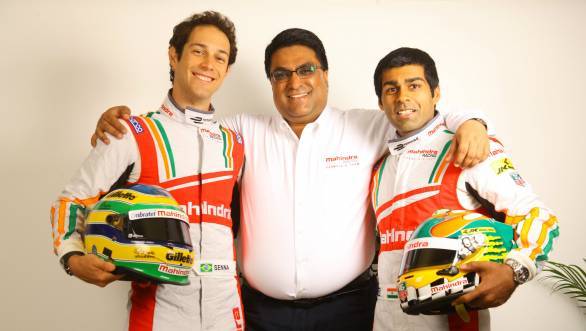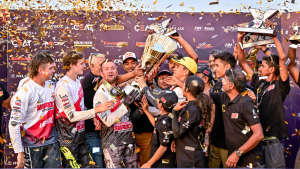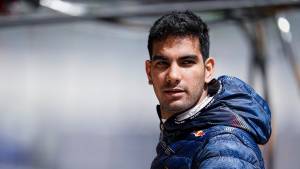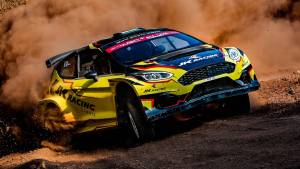Interview: Dilbagh Gill, Team Principal, Mahindra Formula E
OD: Can you tell us about your interest in motorsport prior to Formula E?
DG: I was a motorsport enthusiast ever since I was a child. I did my first rally when I was seventeen and a half years old. I did a little bit of semi-professional rallying in South India both on motorcycles and in cars. My first job out of college was with J Anand in 1993. We prepared the MRF cars for rallying and after that racing at the Sriperumbudur track. So I was basically his chief mechanic, back in 1993 and 1994. We won the championship back then. Then I started a little something of my own. I went to Denmark and did some stuff in engineering, services, etc. So from then my career moved onto different areas. I also realised when I was racing that my enthusiasm was far ahead of my ability. So it was time to give that up. I had helped start a small team in Bangalore - Team Kadur. We used to organise their event too - the Kadur Safari right from year one. So there's always been some work around motorsport in my life. Then I had a small start up of my own in the early 2000s from Chennai. And one of my clients was A1 Grand Prix. So I started working with them, doing all their IT and sport work. In fact, I was one of those who had started the integration between technology and sport in India. And they went on and did the world's largest sporting event - the FIFA World Cup. And that has gone on record of being the first time that we had a tournament that was 100 per cent live from the IT perspective; we also got an award for it. So we've seen stuff from different countries, different scales and different geographies. So I think putting my management (what I've learnt from there), understanding sport, and for the passion of it, that's when I put my hands up and this opportunity came formerly within Mahindra. I was in the group for about eight years. I started with Satyam, now Tech Mahindra. I feel that's the greatest thing about Mahindra - if you stand up and raise your hand, the challenge gets thrown to you. Anand Mahindra asked me a question at Auto Expo this year, he asked me if I wake up at nights worried. And I said yes, I do. So he said great, that's what we need. So to answer your question again, I don't know what I don't know. At the same time I feel I have enough knowledge to put together a team. I'm not driving the car, thankfully, but putting together a team, that will optimally and efficiently work. That's looking at it more from a management perspective rather than motorsport. And I think that's been successful. If you look back in motorsport, when Flavio Briatore came to Benneton and they then won the world championship, he didn't have any motorsport experience. Right now, the current team principal at Ferrari, he's got no motorsport experience either. I think its all about putting the right ingredients together to run a company. You look at it from the perspective of an organisation and I believe I've had some experience to run an organisation of this size.
 Dilbagh Gill, Team Principal Mahindra Formula E, flanked by Bruno Senna and Karun Chandhok, the team's drivers for 2014-2015
Dilbagh Gill, Team Principal Mahindra Formula E, flanked by Bruno Senna and Karun Chandhok, the team's drivers for 2014-2015
OD: Can you tell us how Mahindra Racing got involved in the Formula E championship?
DG: We announced the decision on 28th of November last year. We had a meeting with the CEO of Formula E Holdings, Alejandro Agag, and the head of marketing. We'd been in negotiations for three months before that. So it's been a year since the thoughts and proposals came to us, and that's when Formula E also started coming back into the news. The real activity on the team started from November last year. The last six months we've decided to get our act together and decided that we're committed to it. We're not here to fill the grid, we want to be a team that others benchmark towards. We've got to a point where we are where we want to be, in terms of team performance, development, etc. What we've essentially done is put together a team in the UK, got facilities, got the first chassis, started working on it, the second chassis will be ready on the 1st of June. The first shakedown on 3rd of June, and from there on, the next level of development begins. Once we learn the performance of the chassis, we've made some assumptions, we've made some modeling around the same. Now we need to focus on how to tweak our assumptions to take it forward. We also focus a lot on simulation. That's an area we're investing a lot in. Simulation from a driver's perspective as we need them to get used to these cars. These cars are not conventional gasoline, and are very different to drive. Also our drivers require a lot of 'seat time', in their vehicles. There are certain thoughts that I'm not allowed to share right now, the simulator-based models have been put to use though. We've had Karun sit in a simulator for some time.
OD: Why did you pick Carlin Motorsport to run the team's racing operations?
DG: We know where our strengths lie, and we know where we need help or rather augmentation. Or main strength is the powertrain. Mahindra has had tremendous experience in the same, running electric vehicles for the past 15 years for REVA, etc, through various collaborators or through various partners we've had around the world. We don't think it is our core competence, nor do we want to make it like that in the near future, to run a single seater racecar. So we decided to look for a partner we can work with and come up with a team. We did well. We had the option of quite a few teams over Christmas and January. But we decided to go for one who has won championships earlier. It may not be at an F1 level. F1 becomes a distraction. There is glamour behind it. The series below it are a lot more hard-working and a lot more efficient with their money. And Carlin has been the most successful racing team in all series below F1. So they were our choice. Carlin also has a lot of love for India. The first race Carlin has ever won was with an Indian driver. Carlin has shown that it has the capability and the capacity. Also, their team is the most experienced with Dallara chassis. From F3 to GP3 toGP2, they're one of the largest customers of Dallara. They've competed with ART Grand Prix in GP2. Also, Trevor Carlin is a nice person to work with.
OD: Do you already have the structure of the core team in place?
DG: We have a resource restriction - we are allowed to take 12 team members for a race. Additionally, you have marketing and commercial people, PR, etc. Twelve core mechanics are all there, and they're already working on the car. We're trying to convert them from petrol heads to spark heads. The 12 mechanics are working on all four cars. So eight people get divided into two groups of four each.
OD: Can you tell us about the role Mahindra will play as opposed to the role that Carlin will play in the team?
DG: We would have a lot of input in it. We understand the electric technology better than Carlin. This race is not about being the fastest around the corner, it's about being the most energy efficient. When you speak about strategy, it's going to be a combination of Mahindra and Carlin. They will help us in terms of car servicing as and when we need it. These cars are very different for the drivers. They've always seemed to drive cars where the power remains constant through the race, and the weight decreases. Here, the weight remains constant and the power decreases. So the question here is as power decreases, how do I optimally use it? Also, the electric engine being a lot more efficient than the petrol engine - we're talking 92-93 per cent efficiency. And a lot more throttle also lets you use a lot more energy. There is also a form of racing where the driver can generate a lot more energy back into the car too. So coming back to strategy - how can we help the driver to understand the optimal way of driving around the circuit. Here is where even REVA comes in for strategies. That's where we do a lot of simulations too. You might be the fastest, but that's not going to help you. You could run out of battery in 8 laps instead of 10 laps. You need to cross your mark. That's where the REVA team comes in to help out.
OD: Do you already have a dedicated team from REVA looking into the operations of the Formula E team?
DG: Yes, we do. The thing with REVA is that they look for a battery which lasts the longest. That could do probably 10,000 cycles of charging and recharging. Here we are happy with maybe less than 100 charges, so later we can throw the battery out. So from their perspective the outputs are slightly higher, but they understand the characterisation of it.
OD: Did Carlin Motorsport also have something to do with the driver choice?
DG: Absolutely nothing from Carlin. When we met our potential partners, we did ask for recommendations. But the decision was largely Mahindra's as we've had objectives about how we want to grow the team.
OD: Do you already have drivers in mind for a test and reserve role?
DG: Yes, we do have a couple of people we're looking at for test and reserve roles. It's more for testing. These are more young drivers as we are going to be spending a lot of time in the simulator.
OD: Can you give us names?
DG: We haven't decided yet. The thing is that these guys are already drivers. He might be a GP2 driver; he might be a GP3 driver too. So that's the quality of drivers that will be working with us. They are doing their regular seasons, but at the same time they are enthusiastic enough to spend hours and hours on a simulator.
OD: There have been several proposals for fan interaction in this series. Thoughts?
DG: As this whole Formula E concept has evolved, there have been many ideas that have been proposed. And there are many others still to be proposed. I'm not very sure of what will be the vehicle of fan interaction. But to be clear, there is a lot of fan interaction coming in and we are encouraging it. We want the next generation of motorsport fans to start coming out. And in today's world, they want to interact. I feel that for motorsport to grow we need more people coming in. And especially since these are all in-city races, we take the race to the fan, rather than the other way around.
OD: How much of your racing operations are sustainable?
DG: We make the best effort towards what is available today. Including the power sources that come to charge the batteries at the race track, etc. This is from sustainable, quantifiable and traceable sources.
OD: Does sustainability in terms of transport and logistics fall under the team's purview?
DG: Right now, it's not the responsibility of the team. But we support it terms of all the other products we handle. For example, the lubricants that we take along, we look at from where they come, how sustainable they are, etc. I believe it's the philosophy. We all understand where we're going and we intend to contribute towards it. Also, one of Mahindra's suggestions for Formula E is that once the race is over, we have some car with some battery power still left in it. How do we donate this energy back to the city before we leave? So we've come up with some ideas on how that energy can be left behind under useful bases, before we leave the city.
OD: As a motorsport enthusiast yourself, how successful do you think Formula E will be?
DG: When you talk about success, there are ways to measure it. One is from a pure racing perspective; another could be the success of communicating the efficiency of electric vehicles. And if the series can communicate that electric cars are a true alternative to road cars, I think the series is very successful. If you look back to the Ernst and Young report, Formula E can potentially directly contribute to another 25 million electric vehicles on the road before 2025. I think that's a very successful part of the series. So when I look at sustainability, etc, it's not just from a race perspective. The spectacles for today are the impact of tomorrow.
OD: And what's the one key element that you feel might make the series succeed?
DG: I think you start with taking racing to places where it hasn't been a tradition. Taking racing to the masses and also taking people with known names into the series, and the picture drawn here is that this is going to be good quality racing.
OD: Can you tell us a little bit about the commercial angle and what the costs involved in running the team in association with Formula E Holdings are?
DG: I would rather not get into it, as this is yet to be finalised. But we run under very strict budget caps. This racing series is potentially going to endure itself because there aren't fancy levels of expenses or anything.
OD: How much progress have you made for the 2015 cars that you need to develop on your own?
DG: From Mahindra's perspective, quite a bit. I'm not at liberty to say exactly how we've done it, but I think we're pretty father ahead of the competition. One of the biggest complications we're facing is that the rules and regulations for next year haven't been frozen yet. So for that I've called a meeting with all the ten team principals next week.
OD: What are your areas of focus?
DG: We have started evaluating alternate chemistries for the battery. Basically, our interest focuses on the powertrain. We are of the view that this should not become an aero championship; this should become a power championship.
OD: And how do you think Mahindra will fare compared to the other teams given that you are the only electric car manufacturer on the grid?
DG: I know what we have, and I believe it's something of a benchmark to other teams. I'm not referencing us to be among the leading pack to start with. We do have a lot of knowledge within the team. But the same knowledge is available to other teams as well. I don't know how much they're tapping into it. However, the other teams do have more racing experience. But I feel overall, we are in a position where we are stronger.
OD: Realisitcally what is your aim for the first race of the season?
DG: When we unload the car at the new track, we need to get the initial baseline correct, and that can be done through various simulators, etc. From a driver's perspective, he has one hour of practice. And each driver has to shake down two chassis. Should there be a problem on the car, it's going to take a lot of attention from the mechanics, Because the car has to get ready for qualifying and racing on the same day. So a lot of effort will be spent in seeing that the car can get unloaded from the truck at the right base set up.
OD: And how do you plan on achieving this?
DG: The set up, and the plan/maps that the driver will be working on. Once again, it's not the fastest way but the most efficient way of running on the track.
OD: What's the plan of action leading up to the first race?
DG: I think first we need to start understanding this car. We have a shakedown next week. We're building the second chassis. Then we have official tests in the first week of July. Then there will be a gap for two weeks. After those four days of running, that's when the sprint starts for us. Then three weeks later will be the next test. Now it's more of understanding the electric engines, getting people to go through the electric course, understanding electric engines, start building sub assemblies, like tools specific to this car, etc.
OD: Are your drivers, Karun Chandhok and Bruno Senna, under one year contracts?
DG: In most contracts, we keep options open for a longer period of time.
OD: What are your goals for the 2014-2015 season?
DG: We want to be in the leading pack. We'd like to be in the first bunch.
OD: Are there any teams you think will be a serious threat?
DG: Looking at the situation, there's no one really difficult to challenge. All of us have our strengths and weaknesses. If I make a spread sheet of all us ten teams on it with a record of what we have done and not, you'd realise it's looks good for us.
OD: It's the dash to the finish line for Mahindra Formula E now, isn't it?
DG: Yes. I'd say that our race has started right now. We wanted to get the drivers announcement done with, we have such a component bunch of drivers. We have a team, we have the equipment, now let's focus on the car.














